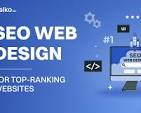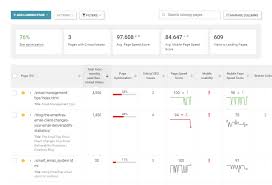The Importance of SEO in Web Design
Search Engine Optimization (SEO) plays a crucial role in the success of a website. When it comes to web design, incorporating SEO strategies is essential for improving visibility and driving organic traffic to your site.
Here are some key reasons why SEO is important in web design:
Improved Search Engine Rankings
By optimizing your website for search engines, you can improve your rankings on search engine results pages (SERPs). This means that your site is more likely to appear higher in search results when users search for relevant keywords related to your business.
Enhanced User Experience
SEO-friendly web design focuses on creating a seamless user experience. By optimizing site speed, mobile responsiveness, and navigation, you can ensure that visitors have a positive experience on your site, which can lead to higher engagement and conversions.
Targeted Traffic
SEO helps you attract targeted traffic to your website. By optimizing your content with relevant keywords and meta tags, you can attract users who are actively searching for products or services that you offer, increasing the likelihood of conversions.
Long-Term Results
Implementing SEO strategies in web design can lead to long-term benefits for your website. By following best practices and staying up-to-date with algorithm changes, you can maintain high search engine rankings and continue driving organic traffic over time.
Competitive Advantage
In today’s competitive online landscape, having a well-optimized website can give you a competitive edge. By outranking competitors in search results and attracting more organic traffic, you can establish your brand as a leader in your industry.
In conclusion, integrating SEO into web design is essential for maximizing the potential of your website. By focusing on optimization techniques from the beginning stages of web development, you can create a site that not only looks great but also performs well in search engines, ultimately leading to increased visibility and success online.
Top 7 FAQs About SEO Web Design: Enhancing Visibility and Performance
- What is SEO web design and why is it important?
- How does SEO impact the design and development of a website?
- What are some key elements of SEO-friendly web design?
- How can responsive design affect SEO performance?
- Why is site speed crucial for SEO in web design?
- What role do keywords play in optimizing a website for search engines?
- How can I measure the success of my SEO web design efforts?
What is SEO web design and why is it important?
SEO web design refers to the practice of creating websites that are optimized for search engines to improve visibility and attract organic traffic. It involves incorporating SEO strategies into the design and development process to ensure that the site ranks well in search engine results pages (SERPs). SEO web design is important because it helps businesses increase their online presence, reach their target audience more effectively, and drive relevant traffic to their website. By focusing on elements such as site structure, mobile responsiveness, page speed, and keyword optimization, SEO web design can enhance user experience, boost search engine rankings, and ultimately lead to higher conversions and business success.
How does SEO impact the design and development of a website?
The impact of SEO on the design and development of a website is significant. SEO considerations influence various aspects of a website, from its structure and layout to its content and functionality. When implementing SEO in web design, factors such as keyword optimization, site speed, mobile responsiveness, user experience, and back-end coding practices all play a crucial role in determining the visibility and performance of the site in search engine results. By integrating SEO best practices early on in the design and development process, websites can be optimized to attract organic traffic, improve search engine rankings, enhance user experience, and ultimately achieve better online success.
What are some key elements of SEO-friendly web design?
When it comes to creating an SEO-friendly web design, there are several key elements to consider. First and foremost, having a well-structured website with clear navigation and user-friendly layout is essential. Incorporating relevant keywords into your website content, meta tags, and URLs can also help improve search engine visibility. Additionally, optimizing images with descriptive alt text, ensuring fast loading times, and making your site mobile-responsive are crucial elements for SEO-friendly web design. By focusing on these key elements, you can enhance your website’s performance in search engine rankings and attract more organic traffic to your site.
How can responsive design affect SEO performance?
Responsive design plays a critical role in SEO performance by ensuring that websites are user-friendly and accessible across various devices, such as desktops, smartphones, and tablets. Google prioritizes mobile-friendly websites in search results, so having a responsive design can positively impact SEO rankings. Responsive design enhances user experience by automatically adjusting the layout and content of a website based on the device being used, which reduces bounce rates and increases engagement. Additionally, a single URL for both desktop and mobile versions of a site simplifies SEO efforts by consolidating link equity and avoiding duplicate content issues. In summary, responsive design not only improves user experience but also boosts SEO performance by making websites more visible and accessible to a wider audience.
Why is site speed crucial for SEO in web design?
Site speed is crucial for SEO in web design because it directly impacts user experience and search engine rankings. A fast-loading website not only provides visitors with a better browsing experience but also signals to search engines that the site is well-maintained and user-friendly. Search engines like Google prioritize websites that load quickly because they want to deliver the best possible results to their users. Slow-loading websites can lead to higher bounce rates, lower engagement, and ultimately lower rankings in search results. Therefore, optimizing site speed is essential for improving SEO performance and ensuring that your website ranks well in search engine results pages.
What role do keywords play in optimizing a website for search engines?
Keywords play a crucial role in optimizing a website for search engines. By strategically incorporating relevant keywords into website content, meta tags, headings, and URLs, you can signal to search engines what your site is about and improve its visibility in search results. Effective keyword research helps identify the terms and phrases that your target audience is searching for, allowing you to tailor your content to meet their needs and attract organic traffic. By optimizing your website with the right keywords, you increase the chances of ranking higher in search engine results pages (SERPs) and reaching a wider audience interested in your products or services.
How can I measure the success of my SEO web design efforts?
Measuring the success of your SEO web design efforts involves tracking various key performance indicators (KPIs) to evaluate the effectiveness of your optimization strategies. Some common metrics to consider include organic search traffic, keyword rankings, click-through rates, bounce rates, conversion rates, and overall website visibility in search engine results pages. By analyzing these metrics regularly and comparing them against your goals and benchmarks, you can gain valuable insights into the impact of your SEO web design efforts and make data-driven decisions to further enhance your website’s performance and visibility online.




